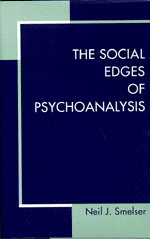

![]()
![]()

Rather than presenting the material chronologically, the eleven essays in the book are divided into four themes. The first theme is entitled 'disciplinary articulations' and deals with how Smelser believes that psychological theories can complement other disciplines to explain the complexity of the social world. The second theme is 'psychoanalytic sociology' and it considers in greater depth how the understanding of some sociological issues could be enriched by applying psychoanalytical theory, and the ways in which this might be accomplished. In the third section, Smelser outlines his theory on 'ambivalence' within social life, and he utilises this concept in looking at several different areas. The final theme aims to make links between studying individuals and studying society, 'the micro-macro connections' as Smelser calls it.
Throughout the book, Smelser's main argument is that in order to understand the complexity of individual life within the social world; the social sciences have been divided into distinct disciplines. Whilst this is usually necessary in order to make sense of the world, it means that each discipline can only explain a fragment of social life. However, by trying to utilise theories from more than one discipline, a better understanding of social life can be achieved.
Smelser does recognise that there are methodological problems and dilemmas in trying to take a multi-disciplined approach. Much of the book is given over to discussing this, as well as the areas where he suggests that psychoanalytical theories could be successfully combined with others such as sociology. The first essays try to address these issues directly, and it is interesting to see how Smelser approached this, given that these are some of his earliest essays. It is clear that he is formulating ideas about recognising 'partial knowledge', and although he still discusses the ways to uncover 'facts', he does appreciate that these will be based on prevailing moral values. Here, it is easy to relate the ideas that Smelser was formulating to post-modern concerns of identity and the rejection of grand narratives.
In the section on 'ambivalence', which contains many of his later essays, Smelser looks at the issues of cultural diversity and affirmative action, mainly using the University of California as an example. However, because the sociological concepts that he employs are not well defined in these essays, his psychoanalytical theories are undermined. He describes the American University system as a 'meritocracy', without explaining either what he means by this term, or why he feels he can make this claim. He continues by explaining that the cultural challenge made by many minority groups undermines this 'meritocracy', and that we can understand the resisting reaction of the resident academics psychoanalytically, as an understandable defence mechanism to this an 'attack' on their 'liberal and tolerant institutions'. Furthermore, Smelser suggests that individuals from minority groups 'ghettoise' themselves on university campuses as a way of dealing with the conflicts that they feel between their home culture and that of the university. However, although he does in this section make reference to the fact that these groups are 'disadvantaged', he does not discuss the effects of racism or any other social discrimination. Consequently, his psychoanalytical explanations of the actions and reactions as the result of ambivalent feelings could be read as excuses for the continuation of existing inequalities, rather than attempts to increase our understanding of individual and institutional reaction to the issues.
Despite these criticisms, however, this collection of Smelser's work introduces many of the broader applications of psychoanalytical theory and gives a clear outline as to the methodological problems of interdisciplinary approaches. Moreover, it is helpful to have all of Smelser's work in this area collated together, and to be able to follow the development of his psychoanalytical ideas and their bearing on other disciplines.
Pam Lowe
University of Warwick